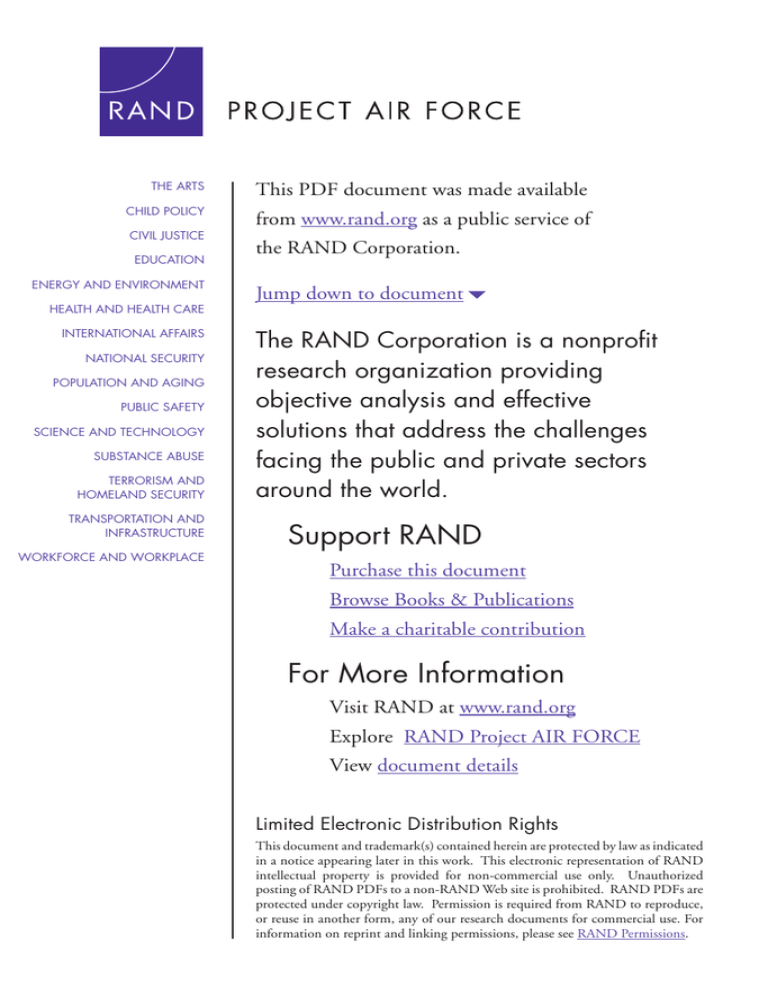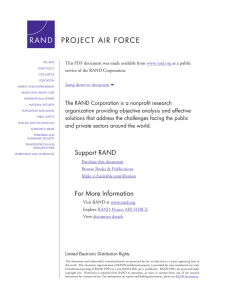
THE ARTS
This PDF document was made available
CHILD POLICY
from www.rand.org as a public service of
CIVIL JUSTICE
EDUCATION
ENERGY AND ENVIRONMENT
HEALTH AND HEALTH CARE
INTERNATIONAL AFFAIRS
NATIONAL SECURITY
POPULATION AND AGING
PUBLIC SAFETY
SCIENCE AND TECHNOLOGY
SUBSTANCE ABUSE
TERRORISM AND
HOMELAND SECURITY
TRANSPORTATION AND
INFRASTRUCTURE
WORKFORCE AND WORKPLACE
the RAND Corporation.
Jump down to document6
The RAND Corporation is a nonprofit
research organization providing
objective analysis and effective
solutions that address the challenges
facing the public and private sectors
around the world.
Support RAND
Purchase this document
Browse Books & Publications
Make a charitable contribution
For More Information
Visit RAND at www.rand.org
Explore RAND Project AIR FORCE
View document details
Limited Electronic Distribution Rights
This document and trademark(s) contained herein are protected by law as indicated
in a notice appearing later in this work. This electronic representation of RAND
intellectual property is provided for non-commercial use only. Unauthorized
posting of RAND PDFs to a non-RAND Web site is prohibited. RAND PDFs are
protected under copyright law. Permission is required from RAND to reproduce,
or reuse in another form, any of our research documents for commercial use. For
information on reprint and linking permissions, please see RAND Permissions.
This product is part of the RAND Corporation monograph series.
RAND monographs present major research findings that address the
challenges facing the public and private sectors. All RAND monographs undergo rigorous peer review to ensure high standards for
research quality and objectivity.
Budget Estimating
Relationships for
Depot-Level
Reparables in the
Air Force Flying
Hour Program
Gregory G. Hildebrandt
Prepared for the United States Air Force
Approved for public release; distribution unlimited
The research described in this report was sponsored by the United States
Air Force under Contracts F49642-01-C-0003 and FA7014-06-C0001. Further information may be obtained from the Strategic Planning
Division, Directorate of Plans, Hq USAF.
Library of Congress Cataloging-in-Publication Data
Hildebrandt, Gregory G.
Budget estimating relationships for depot-level reparables in the Air Force flying
hour program / Gregory G. Hildebrandt.
p. cm.
Includes bibliographical references.
ISBN 978-0-8330-4121-0 (pbk. : alk. paper)
1. Airplanes, Military—United States—Parts—Costs. 2. United States. Air
Force—Equipment—Maintenance and repair—Costs. 3. United States. Air Force—
Accounting. I. Project Air Force (U.S.) II. Title.
UG1243.H55 2007
358.4'18—dc22
2007023609
The RAND Corporation is a nonprofit research organization providing
objective analysis and effective solutions that address the challenges
facing the public and private sectors around the world. R AND’s
publications do not necessarily reflect the opinions of its research clients
and sponsors.
R® is a registered trademark.
© Copyright 2007 RAND Corporation
All rights reserved. No part of this book may be reproduced in any
form by any electronic or mechanical means (including photocopying,
recording, or information storage and retrieval) without permission in
writing from RAND.
Published 2007 by the RAND Corporation
1776 Main Street, P.O. Box 2138, Santa Monica, CA 90407-2138
1200 South Hayes Street, Arlington, VA 22202-5050
4570 Fifth Avenue, Suite 600, Pittsburgh, PA 15213-2665
RAND URL: http://www.rand.org
To order RAND documents or to obtain additional information, contact
Distribution Services: Telephone: (310) 451-7002;
Fax: (310) 451-6915; Email: order@rand.org
Summary
One of the key cost and budget O&S categories is flying DLRs. These
are the reparable spare parts that directly support the USAF Flying
Hour Program. In fiscal year 2002 (FY02), they constituted about
$3.5 billion of total O&S costs of about $24.3 billion, or slightly
greater than 14 percent of the total. It can be argued, however, that it
is a particularly important 14 percent. Because of the direct connection between flying hours and military readiness, fulfilling the Flying
Hour Program is one of the priority objectives of the Air Force. As
a result, the funds budgeted for this program, within a MAJCOM,
are fenced and cannot be moved to other Air Force budget activities without Chief of Staff approval. And, if the budgeted funds are
not adequate to support this program, and additional funding is not
authorized by Congress, funds needed to support the program may be
moved from certain O&M activities by the MAJCOM. As the scale of
these other activities is reduced, their contribution to military readiness would decline.
The O&M-obligated funds finance the “net sales” of the spare
parts by the Materiel Support Division (MSD) of Air Force Materiel
Command (AFMC) to the commands and their parts-demanding
organizations. While other terms have been used, throughout this analysis, we use the term “net sales” to describe the dollar value of the flying
DLR transactions. Because the associated obligations are sanctioned
by budget authorizations, the models that explain net sales are called
budget estimating relationships, or BERs.
xiii
xiv
Budget Estimating Relationships for Depot-Level Reparables
Objective of the Study
The purpose of this research is to support the Air Force Cost Analysis Improvement Group (AFCAIG) flying DLRs budgeting process by
explaining why net sales of these DLRs to the commands are at their
historic levels. The AFCAIG analyzes command inputs on numerous
aircraft Mission Design Series (MDS), submits budget recommendations to the Air Force corporate structure, and develops commandspecific cost per flying hour (CPFH) factors. To both explain the historical data and provide the AFCAIG with a tool to better understand
the commands’ budgetary submissions, we develop several explanatory
BERs to understand why flying DLRs are at their particular levels.
We explain the historical flying DLRs by estimating models that
relate net sales to the contemporaneous values of aircraft characteristics, operational tempo (OPTEMPO), and time-related variables. The
aircraft characteristics are aircraft mission type and flyaway cost; the
OPTEMPO variables are flying hours, average sortie duration (ASD),
and landings per sortie, which capture the macro usage dimensions
of mission profiles; and the time-related variables are fiscal year categorical variables and aircraft MDS age. We also extend the analysis to
account for the serial correlation that occurs across fiscal years.
Explanatory Variables in the BER
If we focus our attention on flying DLR transactions during a particular period, and successfully explain how these budgets change when
specified variables change, the causal structure of flying DLR budget
determination is identified. To achieve this objective, we develop BER
response schedules using data for explanatory variables that are contemporaneous with flying DLR net sales.1 Such response schedules
1
Causality and the role played by response schedules are discussed in Freedman (2005).
Simon (1990) discusses causality in terms of specified mechanism by “how widely we draw
the boundaries of the system to be examined.” The boundaries of this analysis exclude intertemporal phenomenon. We are also isolating the transactional relationship between the base
maintenance organization and base supply from other elements of the supply chain and
repair cycle.
Summary
xv
permit one to estimate how DLR budgets respond to changes in the
explanatory variables. As a result, for an aircraft MDS, if a change in
flying hours is instituted, or there is a change in the retirement profile
that affects the average age of the remaining aircraft, the model can
estimate the effect of such a policy intervention.
Intertemporal Prediction
It is likely that net sales of flying DLRs are also influenced by factors
occurring in prior periods. While it is quite difficult to develop an
explanatory model that characterized the full nature of intertemporal
effects, we can capture the broad forces associated with intertemporal
association by exploiting the serial correlation that exists among the
residuals of subsequent periods. We do this and find that the results of
the contemporaneous causality model are robust. This second model is
particularly useful for predicting net sales.
Statistical Methods Employed
Because of the limited data for each of the aircraft MDS, we employ longitudinal regression statistical methods and explain flying DLR budgets
by analyzing all of the aircraft MDS-command data simultaneously.
We must emphasize that there are significant correlations among
the explanatory variables, but that the multiple-regression estimation
techniques employed are designed to take these into account. Whenever we speak of an explanatory variable having a positive or negative
effect on net sales, we always mean that the values of the other explanatory variables in the model are formally held constant. Our shorthand
for this is “other things equal.”
xvi
Budget Estimating Relationships for Depot-Level Reparables
Empirical Findings
The first model hypothesized includes fiscal year categorical variables,
and we find that these are not statistically significant and are deleted
from the analysis (see p. 42).
In the revised model, which excludes the fiscal year variables, all
aircraft mission types show significantly lower net sales than fighters,
“other things equal.” We also show a significant relationship between
flyaway cost and net sales. A 1 percent increase in flyaway cost increases
net sales by about 0.81 percent (see p. 44).
In this aircraft system model, a 1-percent increase in flying hours
increases net sales by about 1.04 percent. The flying hours effect is so
close to a proportional relationship between flying hours and net sales
that it supports the working assumption of the CPFH AFCAIG budgeting process that there is a proportional relationship between net
sales and flying hours (see p. 44). Under this assumption, changes in
flying hours result in like-proportional changes in net sales.
During peacetime training activities, there have traditionally
been very high correlations among flying hours, sorties, and landings,
which are three different measures of OPTEMPO. As a result, in this
peacetime training environment, it is very difficult to separate the different effects of these three variables on net sales. However, during
contingencies, mission profiles change. ASD increases (see p. 31) and
landings per sortie decrease (see p. 32). Because of the significant
amount of contingency flying in FY02 and FY03, there is now sufficient independent variation in ASD and landings per sortie to incorporate these variables in BERs. We find that ASD has a negative, statistically significant effect on net sales, while landings per sortie have
a significant positive effect.
Aircraft Aging
For the past several years, there has been a strong interest in the aging
effects. When the traditional ordinary least squares (OLS) estimation
technique is used, we show that a one-year increase in MDS age increases
Summary
xvii
net sales by about 2.7 percent (see p. 45). However, we emphasize that
the measured aging effect must be given a broader interpretation than
the simple effect of material degradation. It can also embody the effect
of aircraft modifications, and may be affected by technical progress
that occurs over time, as new aircraft MDS enter the inventory.
Observations on BERs
Our discussion of the explanatory models notes many of the complications associated with constructing such models. Yet in some settings—
say, during the acquisition process—the values of contemporaneous
variables provide the primary input to estimating cost. In such analyses, aircraft type, OPTEMPO, and aircraft age variables are very natural variables to consider. To aid in the validation of budget estimates
developed by the MAJCOMs, and to understand the moving forces
determining net sales, these models may play a useful role. Also, to
predict the value of flying DLRs, the model that accounts for the correlation among the residuals has attractive properties.
The appendix includes several amplifications and extensions. We
address the issue of outliers, and investigate a first-difference model to
better isolate the pure effects of aging and eliminate any possible “nonstationarity” from the data.







